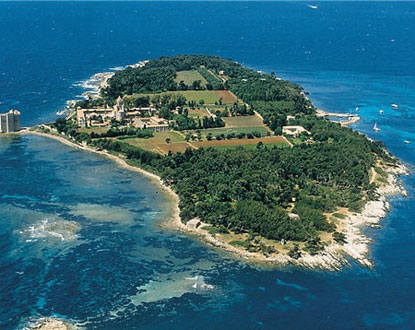The most distant from the mainland, guardian with its tower of the open sea and its dangers, it protects the coastline and the Oratores are there for the salvation of the people.
These voluntarily reclusive monks, a lifestyle choice, invite us to share their prayers and meditations, to taste monastic products, and especially to discover an island untouched by urbanization, a plunge back in time, a salutary return to the sources, those from the dawn of humanity.
When you arrive on this monastic island, after the dock, you will head towards the east. After a few steps in a warm scrubland, you will discover the foundations of an ancient chapel dedicated to Saint Michael, which was once surrounded by a Roman cemetery.
When you take the walk in summer, it is the song of cicadas, rhythmic chirping that accompanies the walker. With a bit of luck and keen eyes, you can spot them clinging to the trunks of maritime pines. We leave on our right the portal of the abbey; an oratory dedicated to the Virgin Mary welcomes us for a moment of repose or devotion.
We resume our pilgrimage to discover this island where prayer and war often intertwined in these struggles between princes who were nevertheless Christians but blinded by the intoxication of power. Soon you will be able to see the vineyards behind a fence, symbolic wicker trellises. The rows of vineyards dance under a light breeze that rustles the leaves and the sea. This cellar produces a wine appreciated by connoisseurs.
The chapel of the Trinity from the 9th and 11th centuries was transformed into a fort by the Spanish invaders in 1635. It is located at the eastern end of Saint Honorat. Now, we find ourselves facing the open sea and can, in the horizon blurred by heat, glimpse ships coming and going, cutting through the waves with their prow and leaving their wake to slowly fade on the sea barely rippled by an Aeolus lazy today.
At the turn of this dirt path, we find ourselves facing the fortified monastery, which from the top of its tower oversees a panorama that stretches to the rock of Théoule. This mound, blocking the west, will ignite in the evening with the sun disappearing behind its summit. The abbey church where one enters for a moment of silence, meditation, and coolness invites introspection. Above the high altar, a Christ is illuminated by Helios and his fiery hair. We continue our walk toward the chapels of Saint Cyprian and Saint Caprais; the latter was a companion of Saint Honorat and lived at this western end of the island in the 5th century.
We reconnect with history, leaving the monastic tranquility with these red-hot ball ovens erected by General Bonaparte facing the danger of English invaders in 1793 to defend Cannes. A final chapel with an octagonal plan, there is a similar one at La Brigue, dating from the 11th century.
After the collapse of its vault, it was rebuilt in a star shape in the 17th century. Having completed our visit, we’ll stop at the island’s arbor where we can verify Rabelais’ assertions, the monks are fine gourmets, and this delicious beer will be much appreciated while we await the boat that will take us back to the mainland.


